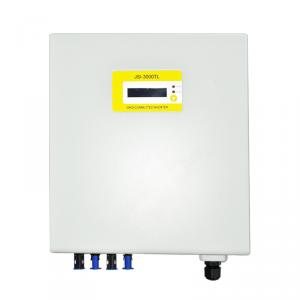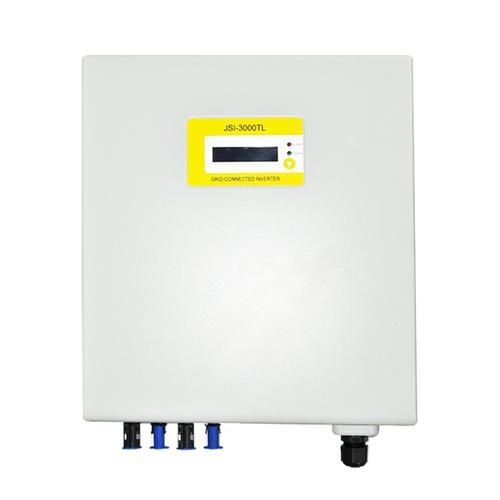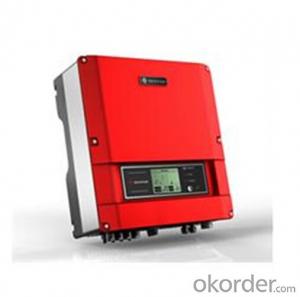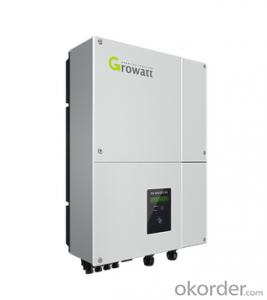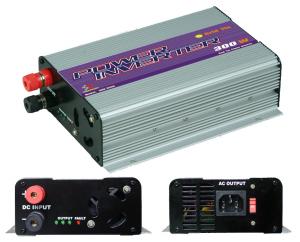Outdoor Solar Inverter 3600W Grid Connected
OKorder Service Pledge
Quality Product, Order Online Tracking, Timely Delivery
OKorder Financial Service
Credit Rating, Credit Services, Credit Purchasing
You Might Also Like
Grid connected solar inverter 3600W
◆ Compact size and high power density
◆ High speed MPPT for real time power tracking and improved energy harvesting
◆ Transformerless operation for highest efficiency 97%
◆ High overload capability under most ambient conditions
◆ Certified grid connected operation according to the international standards
◆ True sine wave output
◆ Integrated RS485/RS232 serial communications
◆ Multi-language LCD display
| MODEL | 1100TL | 1500TL | 2000TL | 2500TL | 3000TL | 3600TL | 5000TL | 6000TL |
| Max. DC Input Power(W) | 1200 | 1750 | 2300 | 2700 | 3660 | 3750 | 5300 | 6400 |
| Max DC Voltage(Vdc) | 450 | 450 | 500 | 550 | ||||
| MPPT Operating Range(Vdc) | 60~450 | 100~450 | 100~500 | |||||
| Number of Parallel Inputs | 1 | 2 | 3 | |||||
| Number of MPPT Trackers | 1 | |||||||
| Max. Input Current(A) | 11.7 | 10 | 13 | 14.5 | 20 | 20 | 22.5 | 27.5 |
| Nominal Output Power(W) | 1100 | 1500 | 2000 | 2490 | 3000 | 3600 | 4600 | 6000 |
| Max. Output Power(W) | 1100 | 1650 | 2200 | 2490 | 3400 | 3600 | 5000 | 6000 |
| Nominal Output Current(A) | 4.8 | 6.5 | 8.7 | 10.8 | 13 | 15.7 | 20 | 26 |
| Max. Output Current(A) | 5.7 | 7.9 | 10.5 | 12 | 15.7 | 16 | 24 | 29.3 |
| Nominal AC Output Voltage(Vac) | 230 | |||||||
| AC Output voltage range (Vac)* | 190~265 | |||||||
| AC Grid frequency range (Hz)* | 50±5 | |||||||
| Power Factor (cosφ) | >0.99 | |||||||
| THDI | <3%(at nominal output power) | |||||||
| Max.efficiency | 96.50% | 96.50% | 97.00% | 97.10% | 97.20% | 97.30% | 97.40% | 97.40% |
| Euro.efficiency | 95.40% | 95.50% | 96.20% | 96.30% | 96.40% | 96.60% | 96.80% | 96.80% |
| MPPT. efficiency | 99.60% | 99.60% | 99.60% | 99.60% | 99.60% | 99.60% | 99.60% | 99.60% |
| Operating Temperature(℃) | -25~+60 | |||||||
| Noise typical[dB(A)] | ≤20dB(A) | |||||||
| Operating Consumption(W) | 0 | |||||||
| Electrical Isolation | Transformerless | |||||||
| Cooling Concept | Natural cooling | |||||||
| Protect Level | IP65 | |||||||
| Communication | RS232(WiFi optional) | |||||||
| Dimension (W×D×H)(mm) | 345*152*315 | 345*152*355 | 345*152*385 | 345*152*505 | 345*162*573 | |||
| Weight (Kg) | 12 | 13 | 15 | 19 | 24 | |||
| *AC grid voltage range and frequency range depend on local standards | ||||||||
- Q: How does a solar inverter handle variations in temperature?
- A solar inverter manages variations in temperature by having built-in thermal management systems that ensure optimal functioning within a specified temperature range. These systems include heat sinks, fans, or liquid cooling to dissipate excess heat generated during operation. Additionally, advanced inverters incorporate temperature sensors and algorithms to monitor and adjust their performance accordingly, maintaining efficiency and protecting the internal components from overheating or freezing in extreme temperatures.
- Q: How do you choose the right output voltage for a solar inverter?
- When choosing the right output voltage for a solar inverter, several factors should be considered. Firstly, it is essential to match the inverter's output voltage with the electrical system or grid requirements of your location. This typically involves understanding the voltage and frequency standards set by the utility company or relevant regulatory body. Additionally, the output voltage should align with the capacity and specifications of the solar panels or array being used. The inverter must be able to handle the maximum voltage and current produced by the solar panels to optimize power generation. Furthermore, the load requirements of the electrical devices or appliances that will connect to the inverter should be taken into account. It is crucial to ensure that the inverter's output voltage is compatible with the voltage needs of the equipment, avoiding any potential damage or inefficiencies. Overall, selecting the appropriate output voltage for a solar inverter involves considering the electrical system standards, solar array specifications, and load requirements to attain optimal performance and compatibility.
- Q: Can a solar inverter be used with dual MPPT inputs?
- Yes, a solar inverter can be used with dual MPPT inputs. Dual MPPT (Maximum Power Point Tracking) inputs allow the inverter to optimize the power output from two separate solar arrays or strings, thereby increasing overall energy efficiency and system performance.
- Q: What are the signs of a faulty solar inverter?
- Some signs of a faulty solar inverter include a complete loss of power generation, inconsistent or fluctuating power output, error messages or fault codes displayed on the inverter, unusual noises or excessive heat coming from the inverter, and a lack of communication or connection with monitoring systems.
- Q: Can a solar inverter be used in three-phase systems?
- Yes, a solar inverter can be used in three-phase systems. In fact, three-phase solar inverters are commonly used in commercial and industrial applications where a three-phase power supply is available. These inverters are designed to convert the DC power generated by solar panels into AC power suitable for use in three-phase systems.
- Q: Can a solar inverter be monitored remotely?
- Yes, a solar inverter can be monitored remotely. Many modern solar inverters have built-in monitoring capabilities that allow users to track the performance and energy production of their solar system from a remote location. This can be done through software applications or web-based platforms that provide real-time data and analytics, enabling users to monitor the system's efficiency, diagnose issues, and optimize its performance without physically being present at the location of the inverter.
- Q: PV grid-connected inverter and independent inverter in the control of what is the difference
- The independent inverter in the output voltage phase amplitude of the frequency control is initially set good. Independent inverter, you should refer to off-grid inverter, do not need to consider the grid situation.
- Q: Can a solar inverter be used with a net metering system?
- Yes, a solar inverter can be used with a net metering system. In fact, a solar inverter is an essential component of a net metering system. It converts the direct current (DC) electricity generated by the solar panels into alternating current (AC) electricity that can be used to power the home or business. The excess electricity produced by the solar panels is fed back into the grid through the net meter, allowing the utility company to credit the owner for the excess energy produced.
- Q: Can a solar inverter be used with a hybrid solar system?
- Yes, a solar inverter can be used with a hybrid solar system. In fact, a solar inverter is an essential component of a hybrid solar system as it converts the DC power generated by the solar panels into AC power that can be used to power electrical devices or be fed into the grid. The inverter also allows for the seamless integration of other power sources, such as a battery storage system or a backup generator, in a hybrid solar system.
- Q: How does a solar inverter affect the value of a property?
- A solar inverter can positively impact the value of a property by enhancing its energy efficiency and reducing electricity costs. This renewable energy technology is attractive to potential buyers as it provides clean and sustainable power generation. Additionally, having a solar inverter installed can increase the overall appeal and marketability of a property, making it more desirable in today's environmentally conscious market.
Send your message to us
Outdoor Solar Inverter 3600W Grid Connected
OKorder Service Pledge
Quality Product, Order Online Tracking, Timely Delivery
OKorder Financial Service
Credit Rating, Credit Services, Credit Purchasing
Similar products
Hot products
Hot Searches
Related keywords
